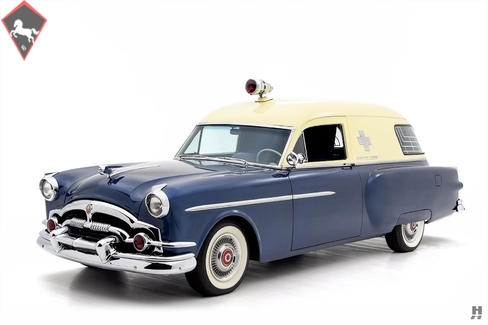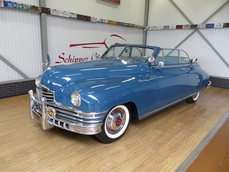Packard Clipper Ambulance 1954
General description :
The Packard Motor Car Company is one of the most storied names in all of motoring. Collectors the world over covet the great motorcars from Detroit for their beauty, quality, and prestige. Packard motorcars have long symbolized wealth and exquisite taste, and the company is a true American icon. Perhaps less well-known, however, was Packard’s long-running commitment to the commercial and professional vehicle trade. Packard contributed substantially to the development of heavy trucks, building their first in 1902, and producing as many as 6,700 units annually during the height of World War I. However, as heavy truck design became increasingly specialized, Packard bowed-out of the business in 1923 to concentrate wholly on passenger cars.
Even with the shift away from heavy trucks, demand remained for so-called “professional cars.” This category included taxis, hired limousines, funeral cars, ambulances, and other specialty vehicles. Much like with road car production, prestige and quality were driving factors in the professional car business, which Packard offered in spades. Firms such as A.J. Miller Company, Knightstown, and Eureka all favored Packard chassis for their funeral cars and hearses. Among the most esteemed commercial coachbuilders was John W. Henney & Company of Cedarville, Illinois. Henney built the world’s first motorized hearse in 1916, and their hand-carved ambulances and hearses were beautifully crafted. Like Packard, Henney built their vehicles up to a standard, rather than down to a price. This shared philosophy would lead Henney to secure an exclusive deal with Packard, much to the annoyance of competitors such as Hess & Eisenhardt. Period advertising touted “The Body is Henney – The Chassis is Packard – The Combination is Exclusive.” The two companies forged a close working relationship, which until Henney’s demise due to mismanagement in 1955.
Featured here is an intriguing 1954 Packard Series 5433 Clipper, outfitted from new by Henney as a Junior short-wheelbase ambulance. Built in the final year of production, this is one of Henney’s rare Junior models, built on the shorter chassis and touted for its performance and maneuverability. This model was favored by the US Military, and it is believed, based on information from the previous owner that this one served on an Air Force base in period. It is a lovely and enjoyable car, with a good quality cosmetic restoration finished in an attractive two-tone scheme of metallic blue with a cream roof. Important original fittings remain intact, including the original light/siren assembly and the stylized chrome crosses, which were a trademark of Henney Ambulances at the time. The body is in very good condition, with high-quality paint and detailing. The extensive chrome plating presents well, with much of it restored to a good standard, mixed with a few finely-preserved original pieces. The presentation is strong, making a bold statement – even without the siren!
The interior is trimmed in complementary blue and off-white upholstery, and it presents in excellent condition. A split bench seat features up front, while a single jump-seat unfolds from the right rear floor. The rear compartment is covered in period-appropriate linoleum flooring. Original equipment includes a rear heater, built-in first aid cabinet, privacy curtains and metal safety bars in quarter windows. The quality of the upholstery and detailing is quite good, again with a mix of restored and excellent original pieces comprising the dash and interior fittings. The odometer shows just over 67,000 miles which may be authentic, considering this car’s relatively easy service life on an air force base.
The Clipper’s 288 cubic-inch inline eight is a proven, robust, and bulletproof design that was well-suited to emergency-services. This example runs exceptionally well, benefitting from meticulous care and sorting by its previous owner, a dedicated Packard enthusiast and collector. The underhood presentation is very good, with features such as an original oil-bath air cleaner and Willard battery lending an authentic feel. The well-sorted, strong-running nature encourages regular use on the road, and it would be a welcome and unique participant on Packard Club or Professional Car Club events. Henney produced just 120 commercial-bodied Clippers in 1954, and it is unknown exactly how many left the plant as Junior-series Ambulances. Survivors are very scarce, particularly those with their original features intact. This wonderful Henney is a rare and fascinating collector piece that would be equally at home in a collection of military or vintage commercial vehicles as it would be in any Packard collection.
https://hymanltd.com/vehicles/6310
1954 Packard Clipper Ambulance is listed sold on ClassicDigest in St. Louis by Mark Hyman for $49500.
Car Facts
Car type : Car Make : Packard Model : Clipper Model Version : Ambulance Engine size : 0.0 Model Year : 1954 Location : Missouri
Sold
Seller Information
Sold
People who viewed this Packard Clipper also viewed similar Packard listed at ClassicDigest
Other cars listed for sale by this dealer
About Packard
Packard: A Comprehensive HistoryEarly Years and Foundation:
Founding: The Packard Motor Car Company was established in 1899 in Warren, Ohio, by James Ward Packard, William Doud Packard, and George Lewis Weiss.
Pioneering Luxury: Initially producing high-quality automobiles, Packard became synonymous with luxury, craftsmanship, and engineering excellence.
Notable Achievements and Contributions:
Packard Twin Six: Introduced in 1916, this V12-powered car established Packard as a premier luxury automobile brand.
Model Line Expansion: Packard expanded its lineup with various models, including sedans, coupes, convertibles, and limousines, catering to affluent customers seeking elegance and performance.
Engineering Innovations: The brand introduced several innovations, such as the first use of aluminum pistons, air conditioning, and the Ultramatic automatic transmission.
Ten Historically Significant Models with Technical Specifications:
Packard Twin Six (1916):
Engine: 7.3L V12 engine.
Performance: Around 85 horsepower.
Packard Eight (1930-1938):
Engine: Straight-8 engine with various displacements.
Performance: Ranged from 90 to over 130 horsepower.
Packard Super Eight (1939-1951):
Engine: Straight-8 engine.
Performance: Produced between 130 to 180 horsepower.
Packard One-Twenty (1935-1942):
Engine: Straight-8 engine.
Performance: Approximately 100 to 120 horsepower.
Packard Clipper (1941-1957):
Engine: V8 engine.
Performance: Ranging from 135 to 185 horsepower.
Packard Caribbean (1953-1956):
Engine: V8 engine.
Performance: Varying between 275 to 310 horsepower.
Packard Patrician (1951-1956):
Engine: Inline-8 and V8 engines.
Performance: Ranged from 150 to 180 horsepower.
Packard Hawk (1958):
Engine: V8 engine.
Performance: Produced around 275 horsepower.
Packard Executive (1956-1958):
Engine: V8 engine.
Performance: Varying between 240 to 290 horsepower.
Packard Predictor (1956):
Engine: Concept car showcasing design and technology.
Performance: Prototype model.
Legacy and Influence:
Quality and Elegance: Packard was revered for its exceptional build quality, refined styling, and luxury features, often considered on par with European luxury brands like Mercedes-Benz.
End of Production: The brand faced financial struggles in the 1950s, leading to its merger with Studebaker and eventual discontinuation in the late 1950s, marking the end of an era in American luxury automobiles.
Packard left an enduring legacy in the automotive industry, symbolizing elegance, engineering excellence, and a commitment to luxury that has been admired and respected by car enthusiasts worldwide.









